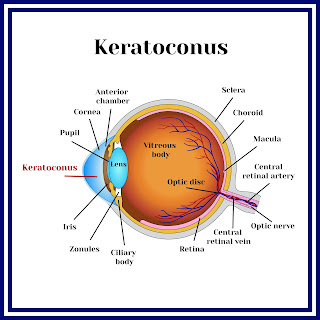What is Keratoconus?
Keratoconus is an eye disorder that leads to the thinning of the cornea. The cornea of the eyes is dome-shaped. Due to progressive thinning, a conical bulge develops in the cornea. It affects the ability of the cornea to focus on images and leads to blurry vision, double vision, astigmatism, sensitivity to light and nearsightedness.
What are the causes of Keratoconus?
Some of the causes of keratoconus are as follows:
- The weakness of collagens can lead to keratoconus. Collagens are tiny fibers of proteins that hold the cornea in place and helps maintain its shape. When these collagens became weak, they are unable to hold the cornea and the dome shape of the cornea changes and becomes conical.
- The imbalance of antioxidants often causes keratoconus. Antioxidants get rid of waste products of the cells of the cornea. The scarcity of antioxidants leads to the destruction of collagens. Collagens helps protect the cornea from bulging out.
- Keratoconus runs in the family. It can affect more than one person in the family. Recent research shows that specific genetic factors are responsible for its prevalence in the same family.
- Keratoconus is also related to sun exposure. The UV rays of the sun damage the shape of the cornea.
- It is also found in people who have the habit of rubbing their eyes
- Allergies that irritate the eyes also causes keratoconus.
- Contact lenses that do not fit properly may also lead to keratoconus.
What are the symptoms of keratoconus?
The most common symptoms of keratoconus are:
- Patients experience minor blurring of vision which progresses gradually and affects the visual clarity.
- Initially, keratoconus is treated like any other eye refractive disorder, and patients are given glasses and contact lenses to do activities like reading and driving.
- As keratoconus progresses, people have difficulty in seeing things that are near as well as far.
- Patients with keratoconus have a poor night vision.
- Keratoconus affects one eye before affecting the other eye. People initially have difficulty in the visual clarity of one eye.
- Sometimes patients develop sensitivity to light.
- People suffering from keratoconus see ghost images, or in other words, they see more than one image of a single thing.
- Patients also see distorted images of things surrounded by light.
How is keratoconus diagnosed?
- Patients having problems with blurry vision may visit the ophthalmologist or optometrist.
- The doctor begins the diagnosis by asking the patient's medical history. The doctor also asks the patient if he has a family history of ocular disease as keratoconus runs in the family.
- An alphabetic chart of progressing small letters is presented to the patient, and the patient is asked to identify the letters to check the visual clarity.
- A manual keratometer is used to measure the curvature of the cornea.
- Retinoscopy is done to see how the retina reacts when beams of light are focused on it. People with keratoconus show scissors reflex action as the doctor focuses the light and then moves it away.
How is keratoconus treated?
Patients are initially given glasses and soft contact lenses to treat astigmatism caused by keratoconus. But, as keratoconus progresses, these may not be sufficient for visual acuity. The following types of special contact lenses are available for further treatment of keratoconus:
- Rigid Gas Permeable (RGP): These contact lenses are initially prescribed to the patients to manage keratoconus. Patients with keratoconus have a smooth lens, but their corneal surface is irregular, the rigid contact lenses fill this gap with tear fluid and create the effect of a smooth cornea and improve visual acuity. Though RGP provides excellent optical clarity, it does not arrest the progression of keratoconus.
- Hybrid contact lenses: RGP lenses are hard, and many people find it very uncomfortable to wear, but the doctor cannot prescribe soft contact lenses to the patients of keratoconus as soft contact lenses conform to the conical shape of the cornea. To tackle this problem, the doctor prescribes a hybrid contact lens which has soft exteriors for the comfort of the patient and hard interiors that does not confirm the conical shape of the cornea.
- Sclera contact lenses: These contact lenses are suggested to the patients with advanced keratoconus, and it provides better visual clarity by covering more surface of the eye.
- Piggyback lenses: Piggyback contact lenses are found comfortable by many patients as hard RGP lenses are worn on top of soft contact lenses.
- Other treatments: When contact lenses do not suffice in providing relief to the patient then the ophthalmologist may suggest treatments like Cornea collagen cross-linking, PTK and Cornea transplant.
Dr. Durocher, a Hendersonville optometrist, believes that we should choose a good optometrist or ophthalmologist who can guide us in choosing the suitable contact lenses and other treatments according to our needs and comfort.
References:
- https://en.m.wikipedia.org/wiki/Keratoconus
- https://www.aao.org/eye-health/diseases/what-is-keratoconus
- http://opmt.com/education/keratoconus/


Thanks for sharing this informative post. If you are suffering from any eye conditions and seeking a safe and effective treatment then visit the Best Eye Hospital In Phagwara named Mitra Eye Hospital & Lasik Laser Centre. It is most preferred hospital for getting the best medical care for any eye disorder.
ReplyDelete